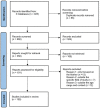A perspective-based analysis of attachment from prenatal period to second year postnatal life
- PMID: 38840732
- PMCID: PMC11150629
- DOI: 10.3389/fpsyg.2024.1296242
A perspective-based analysis of attachment from prenatal period to second year postnatal life
Abstract
Attachment is one of the foundational themes in the history of the psychological development of human beings. For this reason, we assume that it must be approached by taking into account multiple scientific perspectives. The present review aims at analyzing the state of the art regarding the genetic, neurobiological and cognitive mechanisms underlying the development of attachment bonding, considering the child as the frame of reference. We hypothesize that attachment may be present in prototypical forms even in the prenatal period, thus our analysis has a temporal origin in the intrauterine period preceding birth. The intrauterine period is assumed to be a period of maximum sensitivity to stimuli and in particular to those coming from a potential primary caregiver: the biological mother. We conclude with a reframing of the state of the art and propose that future research work would benefit from a superordinate model of attachment, capable of containing and regulating all its components and variables.
Keywords: attachment development; cognition; genetics; neurobiology; prenatal attachment.
Copyright © 2024 Santaguida and Bergamasco.
Conflict of interest statement
The authors declare that the research was conducted in the absence of any commercial or financial relationships that could be construed as a potential conflict of interest.
Figures





Similar articles
-
From pregnancy to 3 months after birth:the beginning of mother-infant relationship from a maternal perspective.J Reprod Infant Psychol. 2022 Jul;40(3):266-287. doi: 10.1080/02646838.2021.1995597. Epub 2021 Oct 23. J Reprod Infant Psychol. 2022. PMID: 34693840
-
Relationship between prenatal and maternal attachment: a longitudinal study from Turkey.J Obstet Gynaecol. 2022 Feb;42(2):220-227. doi: 10.1080/01443615.2021.1904223. Epub 2021 May 24. J Obstet Gynaecol. 2022. PMID: 34027779
-
Postpartum bonding and association with depressive symptoms and prenatal attachment in women with fear of birth.BMC Pregnancy Childbirth. 2022 Jan 25;22(1):66. doi: 10.1186/s12884-021-04367-3. BMC Pregnancy Childbirth. 2022. PMID: 35078403 Free PMC article.
-
Timeline of Intergenerational Child Maltreatment: the Mind-Brain-Body Interplay.Curr Psychiatry Rep. 2017 Aug;19(8):50. doi: 10.1007/s11920-017-0805-7. Curr Psychiatry Rep. 2017. PMID: 28664328 Review.
-
[Neurobiological inscriptions of psychological trauma during early childhood].Psychiatriki. 2012 Jun;23 Suppl 1:27-38. Psychiatriki. 2012. PMID: 22796971 Review. Greek, Modern.
Cited by
-
The impact of early life experiences on inhibitory control and working memory.Front Psychol. 2024 Nov 28;15:1484424. doi: 10.3389/fpsyg.2024.1484424. eCollection 2024. Front Psychol. 2024. PMID: 39669680 Free PMC article.
-
Maternal Perinatal Depression, Alexithymia, and Couple Functioning: Which Relationship Exists with Prenatal Attachment.Behav Sci (Basel). 2024 Sep 2;14(9):773. doi: 10.3390/bs14090773. Behav Sci (Basel). 2024. PMID: 39335988 Free PMC article.
-
Mother-Child Attachment Relationship in Pregnancy, Postpartum, and Early Childhood: Current Status and New Research Perspectives.Eur J Investig Health Psychol Educ. 2024 Aug 1;14(8):2226-2229. doi: 10.3390/ejihpe14080148. Eur J Investig Health Psychol Educ. 2024. PMID: 39194942 Free PMC article.
References
-
- Ainsworth M. D. S. (1967). Infancy in Uganda: infant care and the growth of love. Oxford: Johns Hopkins Press.
-
- Ainsworth M. D. S., Blehar M. C., Waters E., Wall S. (1978). Patterns of attachment: A psychological study of the strange situation: Lawrence Erlbaum.
-
- Assmann B. (2020). “Traces of the invisible world of becoming–epigenetics as a molecular correlate of prenatal psychology” in Handbook of prenatal and perinatal psychology: Integrating research and practice (Cham: Springer International Publishing; ), 169–190.
Publication types
LinkOut - more resources
Full Text Sources

